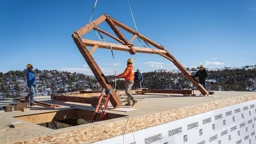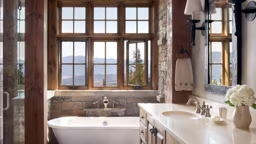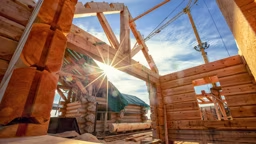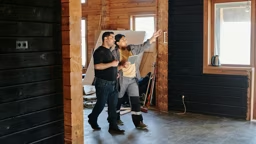Photos: Peg McVay (unless otherwise noted)

The structural insulated panels that enclose Peg and Tony’s timber frame will work with the mechanical systems to keep the home toasty in the winter and cool in the summer. The next step is to install insulated concrete siding fashioned to look like hand-hewn logs.
The last time we checked in with soon-to-be-homeowners Peg McVay and Tony Stramm, they had raised the timbers on their Colorado hilltop and clad the frame in cozy structural insulated panels (SIPs). Now, they’ve started the process of making the home habitable through external materials and mechanical installs.
In this stage of the building process, things can be stop-and-go, and homeowners are at the mercy of material shipping schedules. On the day we spoke to Peg, her concrete log siding, courtesy of ClearCreek Siding, had just arrived. Made of concrete with a foam back, this siding is comparable, price-wise, to brick, but the rustic aesthetic makes it a much better match for the couple’s wooded retreat. Each piece is 12 feet long and about a foot high, including chinking, and interlocks to one another for easy installation.
“When it’s all up, it will look like a hand-hewn log cabin,” says Peg. “You have to spray concrete sealant on it every five to 10 years, according to manufacturer’s directions, but because we’re 8,400 feet above sea level, they suggested we do it every three to five years.” In addition to the aesthetic and maintenance benefits, the siding has an R-8 insulation value. Combined with the R-24 SIP walls and R-40 roof panels the home already has, it will be sealed tight and stand tough against Colorado winters.
For the mechanicals, Peg and Tony designed a utility room in the basement directly beneath their mudroom. In lieu of a traditional furnace, they are opting for a boiler system that will double as their hot water heater. The basement and the first floor also will boast a toasty radiant in-floor heating system, which won’t interfere with the timberwork the way air ducts can.
“We’re trying to make it comfortable, yet efficient,” says Peg. “We have electricity, and we’re going to get propane for the radiant-heat boiler, but we’re also considering solar power and a solar water panel. Then maybe we can install a hybrid system, because the government just extended the 26 percent tax rebate.” Peg is referring to the investment tax credit (ITC) which allows any commercial or residential project to deduct 26 percent of the cost of installing a solar energy system from their federal taxes.
Originally, Peg and Tony dreamed of going completely off the grid but found it to be cost prohibitive. Peg wants a hot tub and Tony has an armory of tools for his planned woodworking shop, so the solar array would need to be huge and ultimately wouldn’t cover their needs. The deal breaker was when the solar rep said they would have to hang their clothes up to dry. Peg chuckled, responding that she worked for 31 years and wanted to be able to put her clothes in a dryer.
The compromise is a solar hybrid system. The pros are that the rebate still applies and it’s more environmentally friendly; the major con being the upfront cost. Fortunately, it’s easy to start with a small solar system and expand on it as you go.
See also: Hybrid Timber Framing to Fit Any Budget
For Peg and Tony, their priority is doing whatever it takes to get their certificate of occupancy. That means finishing the kitchen and the bathrooms.
“We’re still in the camper,” Peg sighs. “We have 35 acres and we’re in the middle of the mountains — that is our godsend. Since the deck was finished, we’ve sat there a few nights and just looked out on the view and the wildlife. There’s a nice size buck; we call him Bucky after the character in ‘The Falcon and the Winter Solider.’ We could watch the 4th of July fireworks in a mountain town nearby. We thought: ‘This is the life — no crowds and we still have fireworks.’”
Stay Tuned!
Join us as we navigate the design process with the homeowners and Timbercraft. Check out the next Dirt to Done installment in our February 2022 issue, where we’ll join Peg and Tony as they finish the interior of this one-of-a-kind hilltop timber home. You can find all the latest installments of the Dirt to Done series in the print magazine and here on timberhomeliving.com. Plus! Stay tuned for new webinars that dive into the process of creating this home.












